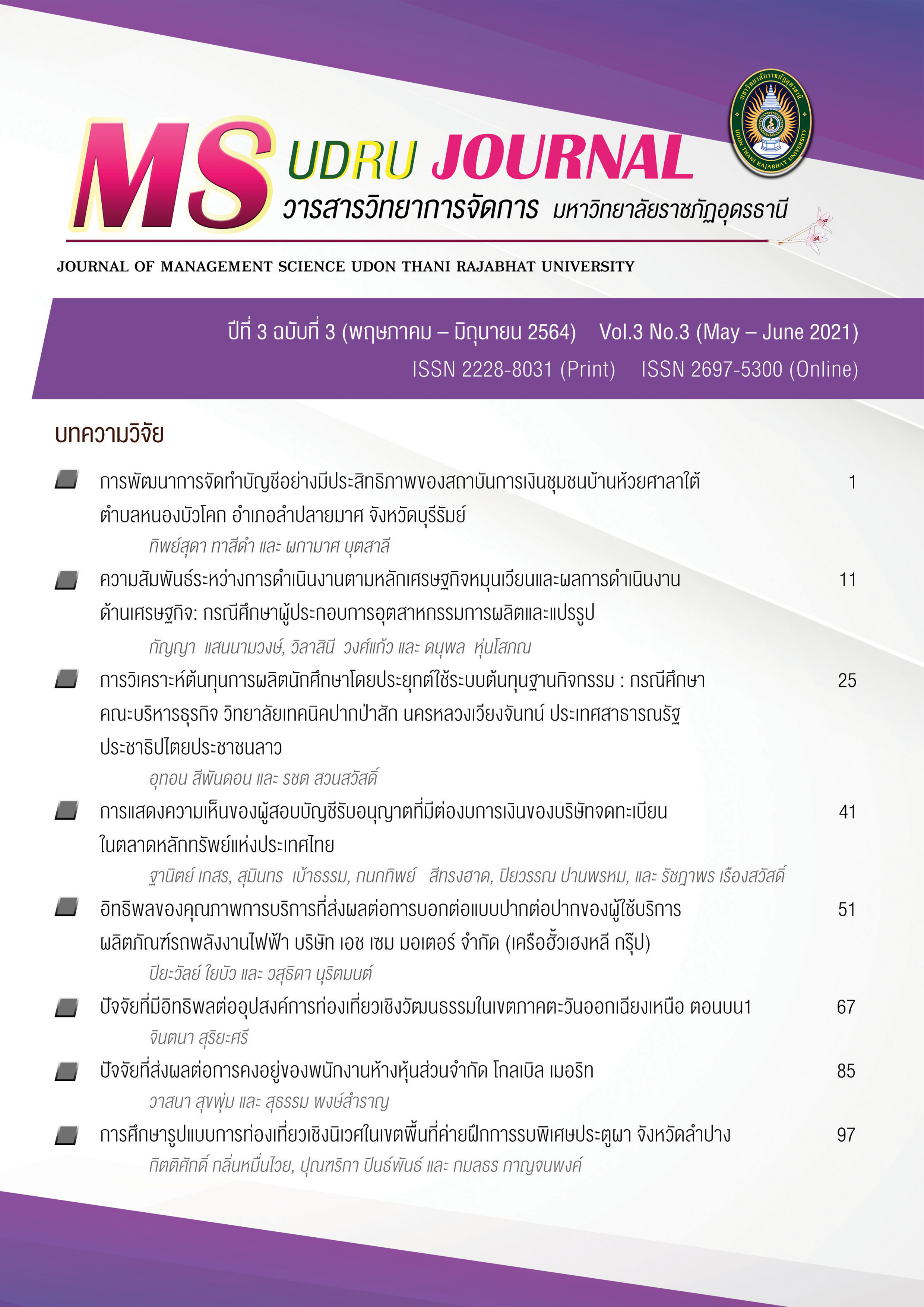THE RELATIONSHIP BETWEEN CIRCULAR ECONOMY OPERATIONS AND ECONOMIC PERFORMANCE: A STUDY OF MANUFACTURING AND PROCESSING INDUSTRIES
Main Article Content
Abstract
The purpose of this research is to study the relationship between circular economy operations and economic performance of manufacturing and processing industries in Thailand. To collect data, questionnaire survey is used. Multiple regression analysis is used to analyze data from 87 firms in nine high-polluting industries. The results show that circular supplies have a positive relationship with firm’s economic performance at statistically significant level of 0.01. Therefore, firms may adopt circular supplies to strengthen their resources security and sustainable competitive advantage.
Article Details

This work is licensed under a Creative Commons Attribution-NonCommercial-NoDerivatives 4.0 International License.
บทความที่ได้รับการตีพิมพ์เป็นลิขสิทธิ์ของคณะวิทยาการจัดการ มหาวิทยาลัยราชภัฏอุดรธานี
ข้อความที่ปรากฏในบทความแต่ละเรื่องในวารสารวิชาการเล่มนี้ ไม่ใช่ความคิดเห็นและความรับผิดชอบของผู้จัดทำ บรรณาธิการ กองบรรณาธิการ และคณะวิทยาการจัดการ มหาวิทยาลัยราชภัฏอุดรธานี ความรับผิดชอบด้านเนื้อหาและการตรวจร่างบทความแต่ละเรื่องเป็นความคิดเห็นของผู้เขียนบทความแต่ละท่าน
References
กรุณา บัวคำศรี. (2562). รอบโลก by กรุณา บัวคำศรี | แฟชั่นเบื่อง่าย หน่ายเร็ว. สืบค้นเมื่อ 22 ตุลาคม 2563, จาก https://www.youtube.com/watch?v=28Nnn4VESzQ
การนิคมอุตสาหกรรมแห่งประเทศไทย (กนอ.). (2563). ค้นหาโรงงาน. สืบค้นเมื่อ 29 มีนาคม 2563, จาก https://www.ieat.go.th/ieat-industry-port-factory/ieat-factory-search
พิมพ์ใจ พิมพ์พิลา. (2563). ‘BOPE’ แบรนด์รักษ์โลกไทย ที่ใช้ประโยชน์จากขยะพลาสติกจนหยดสุดท้าย. สืบค้นเมื่อ 14 ตุลาคม 2563, จาก https://www.smethailandclub.com/entrepreneur-5729-id.html
บริษัท พีทีที โกลบอล เคมิคอล จำกัด (มหาชน). (2562). ปตท. – พีทีที โออาร์ – จีซี เปิด คาเฟ่ อเมซอน เซอร์คูล่า ลิฟวิ่ง คอนเซ็ปต์ แห่งแรกของไทย ใส่ใจสิ่งแวดล้อม ร่วมสร้างสรรค์ผลิตภัณฑ์ตกแต่งร้านจากขยะแปรรูป. สืบค้นเมื่อ 14 ตุลาคม 2563, จาก https://www.pttgcgroup.com/th/updates/news/1112/
บริษัท เอ็น15 เทคโนโลยี จำกัด, (ม.ป.ป.) สืบค้นเมื่อ 14 ตุลาคม 2563, จาก http://www.n15technology.com
ประชาชาติธุรกิจออนไลน์. (2563). ธุรกิจโคม่า ปลดคนรายวัน ปิด 4 พันโรงงาน ช็อกระลอกสอง. สืบค้นเมื่อ 14 ตุลาคม 2563, จาก https://www.prachachat.net/csr-hr/news-485802
ประสพชัย พสุนนท์. (2557). ความเชื่อมั่นของแบบสอบถามในการวิจัยเชิงปริมาณ. วารสารปาริชาต มหาวิทยาลัยทักษิณ, 27(1), 144-163.
พุทธชาด ลุนคำ. (2563). แนวโน้มธุรกิจ/อุตสาหกรรม ปี 2563-65 ธุรกิจนิคมอุตสาหกรรม มกราคม 2563. สืบค้นเมื่อ 29 มีนาคม 2563, จาก https://www.krungsri.com/bank/th/Other/research/industry/industry-outlook.html?page=2
ราชกิจจานุเบกษา. (2563). ประกาศสถานการณ์ฉุกเฉินในทุกเขตท้องที่ทั่วราชอาณาจักร. สืบค้นเมื่อ 14 ตุลาคม 2563, จาก http://www.ratchakitcha.soc.go.th/DATA/PDF/2563/E/069/T_0001.PDF
สำนักงานด้านที่ปรึกษาอุตสาหกรรมในต่างประเทศ.(2559) เศรษฐกิจหมุนเวียน (Circular Economy). สืบค้นเมื่อ 13 ตุลาคม 2563, จาก https://thaiindustrialoffice.wordpress.com/2016/07/03
อัญชลีพร ใสสุทธิ์ และคณะ (2563). นวัตกรรมทางการบัญชีสิ่งแวดล้อมที่ส่งผลต่อการอยู่รอดขององค์กร: กรณีศึกษาของธุรกิจที่ได้รับการรับรอง ISO 14001 ในประเทศไทย. วารสารวิทยาการจัดการ มหาวิทยาลัยราชภัฏอุดรธานี, 2(3), 29-41.
อาภารัตน์ มหาขันธ์ และ เรวดี อนุวัฒนา. (2562). Circular Economy เศรษฐกิจหมุนเวียน...ที่ทุกคนควรรู้. พิมพ์ครั้งที่ 1. ปทุมธานี: กระทรวงวิทยาศาสตร์และเทคโนโลยีแห่งประเทศไทย (วว.).
Aragón-Correa, J. A. (1998). Strategic proactivity and firm approach to the natural environment. Academy of management journal, 41(5), 556-567.
Banerjee, S. B., Iyer, E. S., & Kashyap, R. K. (2003). Corporate environmentalism: Antecedents and influence of industry type. Journal of marketing, 67(2), 106-122.
Bocken, N. M., De Pauw, I., Bakker, C., & van der Grinten, B. (2016). Product design and business model strategies for a circular economy. Journal of Industrial and Production Engineering, 33(5), 308-320.
Burnett, R. D., & Hansen, D. R. (2008). Ecoefficiency: Defining a role for environmental cost management. Accounting, Organizations and Society, 33(6), 551-581.
Chen, D., et al. (2016). "Survival strategy of OEM companies: a case study of the Chinese toy industry." International Journal of operations & Production Management., 36(9) 1065-1088.
Chen, Y.-S., Lai, S.-B., & Wen, C.-T. (2006). The influence of green innovation performance on corporate advantage in Taiwan. Journal of business ethics, 67(4), 331-339.
Christ, K. L., & Burritt, R. L. (2013). Environmental management accounting: the significance of contingent variables for adoption. Journal of cleaner production, 41, 163-173.
De los Rios, I. C., & Charnley, F. J. (2017). Skills and capabilities for a sustainable and circular economy: The changing role of design. Journal of cleaner production, 160, 109-122.
Durongwatana, S. (2015). Regression Models: Analytics-based Approach. Bangkok: Protexts.com.
Farré, Kenji. (2020). “Don’t Buy This Jacket” — Patagonia’s Daring Campaign Marketing lessons from a company defying the odds. Retrieved October 15, 2020, from https://medium.com/better-marketing/dont-buy-this-jacket-patagonia-s-daring-campaign-2b37e145046b
González-Benito, J., & González-Benito, Ó. (2005). A study of the motivations for the environmental transformation of companies. Industrial Marketing Management, 34(5), 462-475.
Hazzi, O., & Maldaon, I. (2015). A pilot study: Vital methodological issues. Business: Theory and Practice, 16(1), 53-62.
Henri, J. F., & Journeault, M. (2018). Antecedents and Consequences of Eco‐Control Deployment: Evidence from Canadian Manufacturing Firms. Accounting Perspectives, 17(2), 253-273.
Journeault, M., De Ronge, Y., & Henri, J.-F. (2016). Levers of eco-control and competitive environmental strategy. The British Accounting Review, 48(3), 316-340.
McKinsey & Company. (2014). Moving toward a circular economy. Retrieved October 22, 2020, from https://www.mckinsey.com/business-functions/sustainability/our-insights/moving-toward-a-circular-economy#
Melnyk, S. A., Sroufe, R. P., & Calantone, R. (2003). Assessing the impact of environmental management systems on corporate and environmental performance. Journal of operations management, 21(3), 329-351.
Mokhtar, N., Jusoh, R., & Zulkifli, N. (2016). Corporate characteristics and environmental management accounting (EMA) implementation: evidence from Malaysian public listed companies (PLCs). Journal of cleaner production, 136, 111-122.
Moraga, G., Huysveld, S., Mathieux, F., Blengini, G. A., Alaerts, L., Van Acker, K., De Meester, S., & Dewulf, J. (2019). Circular economy indicators: What do they measure? Resources, Conservation and Recycling, 146, 452-461.
Moreloop. (n.d.). Moreloop. Retrieved October 14, 2020, from https://moreloop.ws/
Plaza‐Úbeda, J., Burgos‐Jiménez, J., Vazquez, D., & Liston‐Heyes, C. (2009). The ‘win–win’paradigm and stakeholder integration. Business Strategy and the Environment, 18(8), 487-499.
Setthasakko, W. (2010). Barriers to the development of environmental management accounting: An exploratory study of pulp and paper companies in Thailand. EuroMed Journal of Business, 5(3), 315-331.
Suansawat, R. (2013). The Influence of Supply Chain Integration and Green Supply Chain Management Practices on Sustainable Firm Performance in Thai Manufacturing Industry. Degree of Doctor of Philosophy, The university of Hull.
Tonlé. (n.d.), Retrieved October 22, 2020, from https://tonle.com/
Virtanen, T., Tuomaala, M., & Pentti, E. (2013). Controllability in a search for sustainability—case: energy efficiency in process industry. Management accounting research, 24, 401-416.
White, D. & Luo, A. (2005). Business survey response rates—Can they be improved. in The American Statistical Association Proceedings of the Section on Survey Research Methods, 3666-3668.
Whitehead, B., & Walley, N. (1994). It's not easy being green. Harvard Business Review, 72(3), 171-180.
Zink, T. and R. Geyer (2017). Circular economy rebound. Journal of Industrial Ecology, 21(3), 593-602.


